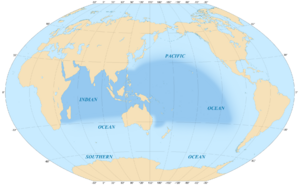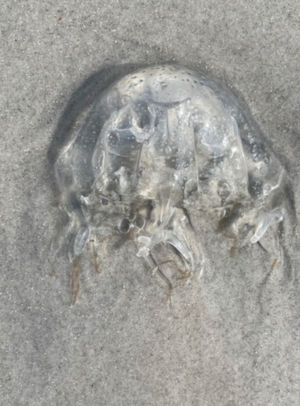Box jellyfish facts for kids
Quick facts for kids Box jellyfish |
|
|---|---|
 |
|
| Chironex sp. | |
 |
|
| Carukia barnesi | |
| Scientific classification |
|
| Kingdom: | Animalia |
| Phylum: | Cnidaria |
| Subphylum: | Medusozoa |
| Class: | Cubozoa Werner, 1973 |
| Orders | |
|
|
Box jellyfish (class Cubozoa) are cnidarian invertebrates distinguished by their box-like (i.e. cube-shaped) body. Some species of box jellyfish produce potent venom delivered by contact with their tentacles. Stings from some species, including Chironex fleckeri, Carukia barnesi, Malo kingi, and a few others, are extremely painful and often fatal to humans.
Contents
Taxonomy and systematics
At least 51 species of box jellyfish were known as of 2018. These are grouped into two orders and eight families. A few new species have since been described, and it is likely that additional undescribed species remain.
Cubozoa represents the smallest cnidarian class with approximately 50 species.
Class Cubozoa
- Order Carybdeida
- Family Alatinidae
- Family Carukiidae
- Family Carybdeidae
- Family Tamoyidae
- Family Tripedaliidae
- Order Chirodropida
- Family Chirodropidae
- Family Chiropsalmidae
- Family Chiropsellidae
Description

The medusa form of a box jellyfish has a squarish, box-like bell, from which its name is derived. From each of the four lower corners of this hangs a short pedalium or stalk which bears one or more long, slender, hollow tentacles. The rim of the bell is folded inwards to form a shelf known as a velarium which restricts the bell's aperture and creates a powerful jet when the bell pulsates. As a result, box jellyfish can move more rapidly than other jellyfish; speeds of up to 6 metres (20 ft) per minute have been recorded.
In the center of the underside of the bell is a mobile appendage called the manubrium which somewhat resembles an elephant's trunk. At its tip is the mouth. The interior of the bell is known as the gastrovascular cavity. It is divided by four equidistant septa into a central stomach and four gastric pockets. The eight gonads are located in pairs on either side of the four septa. The margins of the septa bear bundles of small gastric filaments which house nematocysts and digestive glands and help to subdue prey. Each septum is extended into a septal funnel that opens onto the oral surface and facilitates the flow of fluid into and out of the animal.
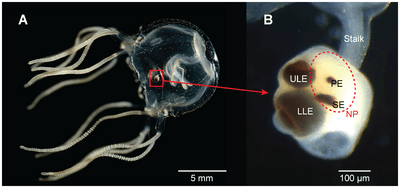
The box jellyfish's nervous system is more developed than that of many other jellyfish. They possess a ring nerve at the base of the bell that coordinates their pulsing movements, a feature found elsewhere only in the crown jellyfish. Whereas some other jellyfish have simple pigment-cup ocelli, box jellyfish are unique in the possession of true eyes, complete with retinas, corneas and lenses. Their eyes are set in clusters at the ends of sensory structures called rhopalia which are connected to their ring nerve. Each rhopalium contains two image forming lens eyes. The upper lens eye looks straight up out of the water with a field of view that matches Snell's window. In species such as Tripedalia Cystophora, the upper lens eye is used to navigate to their preferred habitats at the edges of mangrove lagoons by observing the direction of the tree canopy. The lower lens eye is primarily used for object avoidance. Research has shown that the minimum visual angle for obstacles avoided by their lower lens eyes matches the half-widths of their receptive fields. Each rhopalium also has two pit eyes on either side of the upper lens eye which likely act as mere light meters, and two slit eyes on either side of the lower lens eye which are likely used to detect vertical movement. In total, the box jellyfish have 6 eyes on each of their 4 rhopalia, creating a total of 24 eyes. The rhopalia also feature a heavy crystal-like structure called a statolith, which, due to the flexibility of the rhopalia, keep the eyes oriented vertically regardless of the orientation of the bell.
Box jellyfish also display complex, probably visually-guided behaviors such as obstacle avoidance and fast directional swimming. Research indicates that, owing to the number of rhopalial nerve cells and their overall arrangement, visual processing and integration at least partly happen within the rhopalia of box jellyfish. The complex nervous system supports a relatively advanced sensory system compared to other jellyfish, and box jellyfish have been described as having an active, fish-like behavior.
Depending on species, a fully grown box jellyfish can measure up to 20 cm (8 in) along each box side (30 cm or 12 in in diameter), and the tentacles can grow up to 3 m (10 ft) in length. Its weight can reach 2 kg (4+1⁄2 lb). However, the thumbnail-sized Irukandji is a box jellyfish, and lethal despite its small size. There are about 15 tentacles on each corner. Each tentacle has about 500,000 cnidocytes, containing nematocysts, a harpoon-shaped microscopic mechanism that injects venom into the victim. Many different kinds of nematocysts are found in cubozoans.
Distribution
Although the notoriously dangerous species of box jellyfish are largely restricted to the tropical Indo-Pacific region, various species of box jellyfish can be found widely in tropical and subtropical oceans (between 42° N and 42 °S), including the Atlantic Ocean and the east Pacific Ocean, with species as far north as California (Carybdea confusa), the Mediterranean Sea (Carybdea marsupialis) and Japan (such as Chironex yamaguchii), and as far south as South Africa (for example, Carybdea branchi) and New Zealand (such as Copula sivickisi). Though box jellies are known to inhabit the Indo-Pacific region, there is very little collected data or studies proving this. It was only in 2014, that the first ever box jelly sightings (Tripedalia cystophora) were officially published in Australia, Thailand and the Indian Ocean. There are three known species in Hawaiian waters, all from the genus Carybdea: C. alata, C. rastoni, and C. sivickisi. Within these tropical and subtropical environments, box jellyfish tend to reside closer to shore. They have been spotted in near-shore habitats such as mangroves, coral reefs, kelp forests, and sandy beaches.
Recently, in 2023, a new genus and species of box jellyfish was discovered in the Indo-Pacific region, specifically the Gulf of Thailand. Discovered and named after scientist L. A. Gershwin, this new species of box jellyfish, Gershwinia thailandensis, is a member of the Carukiidae family. Gershwinia thailandensis is described as its own new species as it has sensory structures with specialized horns and lacks a common digestive system among box jelly, the stomach gastric phaecellae. Due to this and other observations, structural and biological, Gershwinia thailandensis was accepted as a new species of box jellyfish.
Detection
Cubozoans are widely distributed throughout tropical and subtropical regions, yet the detection of these organisms can be quite difficult and costly due to a high amount of variation in their occurrence and abundance, their translucent body, two different life stages (medusa and polyp), and vast amounts of size variability within the different species in the class Cubozoa.
Ecology
Age and growth
It has been found that the statoliths, which are composed of calcium sulfate hemihydrate, exhibit clear sequential incremental layers, thought to be laid down on a daily basis. This has enabled researchers to estimate growth rates, ages, and age to maturity. Chironex fleckeri, for example, increases its inter-pedalia distance (IPD) by 3 mm (1⁄8 in) per day, reaching an IPD of 50 mm (2 in) when 45 to 50 days old. The maximum age of any individual examined was 88 days by which time it had grown to an IPD of 155 mm (6 in). In the wild, the box jellyfish will live up to 3 months, but can survive up to seven or eight months in a science lab tank.
Behavior
The box jellyfish actively hunts its prey (small fish), rather than drifting as do true jellyfish. They are strong swimmers, capable of achieving speeds of up to 1.5 to 2 metres per second or about 4 knots (7.4 km/h; 4.6 mph). and rapidly turning up to 180° in a few bell contractions. Some species are capable to avoid obstacles.
The majority of box jellyfishes feed by extending their tentacles and accelerating for a short time upwards, then turn upside-down and stop pulsating. Then the jellyfish slowly sinks, until prey finds itself entangled by tentacles. At this point the pedalia fold and bring the prey to the oral opening.
The venom of cubozoans is distinct from that of scyphozoans, and is used to catch prey (small fish and invertebrates, including prawns and bait fish) and for defence from predators, which include the butterfish, batfish, rabbitfish, crabs (blue swimmer crab) and various species of turtle including the hawksbill sea turtle and flatback sea turtle. It seems that sea turtles are unaffected by the stings because they seem to relish box jellyfish.
Reproduction
Cubozoans usually have an annual life cycle. Box jellyfish reach sexual maturity when their bell diameter reaches 5 millimeters. Chirodropida reproduces by external fertilization. Cubozoas are the only class of cnidarian that contains species that perform the “wedding dance” to transfer the spermatophores from the male into the females, including the Carybdea sivickisi species.
It is previously believed that medusa species only reproduce once in their life before dying a few weeks later, a semelparity lifestyle. Alternatively, in July 2023, the box jelly species Chiropsalmus quadrumanus, were found to potentially have iteroparous reproduction, meaning they reproduce multiple times in their life. Oogenesis appears to happen numerous times as oocytes are discovered in four stages; pre-vitellogenic, early vitellogenic, mid vitellogenic, and late vitellogenic. Continuous research needs to be conducted to determine if box jellyfish are semelparity or iteroparous, or if it is species dependent.
Danger to humans
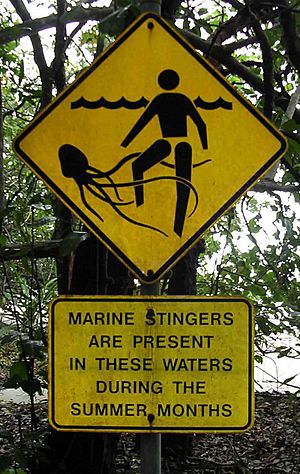
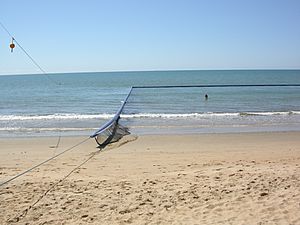
Box jellyfish have been long known for their powerful sting. Stings from the box jellyfish can lead to skin irritation, cardiotoxicity, and can even be fatal.
The lethality of the Cubozoan venom to humans is the primary reason for its research. Although unspecified species of box jellyfish have been called in newspapers "the world's most venomous creature" and the deadliest creature in the sea, only a few species in the class have been confirmed to be involved in human deaths; some species are not harmful to humans, possibly delivering a sting that is no more than painful.
Protection and treatment
Protective clothing
Wearing pantyhose, full body lycra suits, dive skins, or wetsuits is an effective protection against box jellyfish stings. The pantyhose were formerly thought to work because of the length of the box jellyfish's stingers (nematocysts), but it is now known to be related to the way the stinger cells work. The stinging cells on a box jellyfish's tentacles are not triggered by touch, but by chemicals found on skin, which are not present on the hose's outer surface, so the jellyfish's nematocysts do not fire.
First aid for stings
Once a tentacle of the box jellyfish adheres to skin, it pumps nematocysts with venom into the skin, causing the sting and agonizing pain. Flushing with vinegar is used to deactivate undischarged nematocysts to prevent the release of additional venom. A 2014 study reported that vinegar also increased the amount of venom released from already-discharged nematocysts; however, this study has been criticized on methodological grounds.
Vinegar is made available on Australian beaches and in other places with venomous jellyfish.
Removal of additional tentacles is usually done with a towel or gloved hand, to prevent secondary stinging. Tentacles can still sting if separated from the bell, or after the creature is dead. Removal of tentacles may cause unfired nematocysts to come into contact with the skin and fire, resulting in a greater degree of envenomation.
Although commonly recommended in folklore and even some papers on sting treatment, there is no scientific evidence that urine, ammonia, meat tenderizer, sodium bicarbonate, boric acid, lemon juice, fresh water, steroid cream, alcohol, cold packs, papaya, or hydrogen peroxide will disable further stinging, and these substances may even hasten the release of venom. Heat packs have been proven for moderate pain relief. The use of pressure immobilization bandages, methylated spirits, or vodka is generally not recommended for use on jelly stings.
Possible antidotes in humans
In 2011, researchers at the University of Hawaii announced that they had developed an effective treatment against the stings of Hawaiian box jellyfish by "deconstructing" the venom contained in their tentacles. Its effectiveness was demonstrated in the PBS Nova episode "Venom: Nature's Killer", originally shown on North American television in February 2012. Their research found that injected zinc gluconate prevented the disruption of red blood cells and reduced the toxic effects on the cardiac activity of research mice. It was later found that copper gluconate was even more effective. A cream containing copper gluconate has been produced, to be applied to inhibit the injected venom; although it is used by U.S. military divers, evidence that it is effective in humans is only anecdotal.
In April 2019, a team of researchers at the University of Sydney announced that they had found a possible antidote to Chironex fleckeri venom that would stop pain and skin necrosis if administered within 15 minutes of being stung. The research was the result of work done with CRISPR whole genome editing in which the researchers selectively deactivated skin-cell genes until they were able to identify ATP2B1, a calcium transporting ATPase, as a host factor supporting cytotoxicity. The research showed the therapeutic use of existing drugs targeting cholesterol in mice, although the efficacy of the approach had not been demonstrated in humans.
See also
 In Spanish: Cubozoos para niños
In Spanish: Cubozoos para niños


